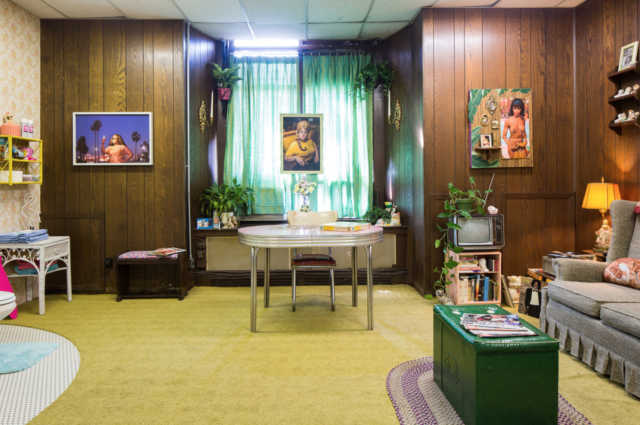
Image via: Spring Break
Art fairs aren’t cheap. Participating galleries take on additional real estate costs, not to mention shipping and staffing expenses. These costs add up. As a result, some dealers in the emerging market are starting to renegotiate the common 50/50 commission split between artists and galleries.
While changing expectations is rarely easy, the dealers we spoke with largely viewed these renegotiations as a necessity. “At the lower end of these things (i.e. not Boesky et al) I think this makes a lot of sense as the cost of these fairs is so astronomical it becomes impossible to recoup them—and if the artist’s works are not 200K there is really no way,” said Allegra LaViola of the Lower East Side gallery Sargent’s Daughter’s. The gallery has not participated in any fairs, but LaViola attends many and has participated in fairs under the name of her previous gallery, Allegra LaViola Gallery.
How those costs get recouped, though, can differ radically from gallery to gallery, often without much agreement on what’s fair. Muriel Guepin Gallery offers one of the more contentious arrangements. Guepin asks artists to engage in a full partnership with the gallery when participating in a fair, a change she said was made after realizing she was only covering her costs. “Let’s say a fair cost is 10K and there are 2 artists,” she told me over email. “The cost of showing the work for each artists is 5K. I actually pay for the fair (no money from the artist), but until we sell for 5K I keep all the money to pay for expenses. After 5K, we split. If there are no sales, I can take artworks valued at 5K to try to sell them later and recoup the cost. If I can’t sell the work, I have lost 5K, worked for free, paid someone to replace me at the gallery. The artist has not put any money upfront but has given an artwork valued at 5K.”
With this arrangement, the artists—either by sale or barter—cover the cost of the booth. When I asked other gallerists about the model, some said they’d never heard of a booth being covered in its entirety by artists, while others told me she wasn’t the only one with that split. Magda Sawon, a co-owner of Postmasters Gallery in TriBeCa, acknowledges that the new environment is challenging but had problems with this particular arrangement. “Mid-level galleries operate in an extremely challenging market at the moment, so efforts to sustain/survive need to include innovation,” she wrote. “The model you describe, though, strikes me as a way too convenient pseudo-“partnership” for the dealer—a deal in which the artists effectively pay for the booth. Any primary gallery gets 50% from sales of art and that 50% is not risk-free, investment-free money aka pure profit. I’m from the ‘artist-first’ school where a dealer covers expenses of exhibitions AND art fairs.”
LaViola told me she’d never charged artists for a booth, and Benjamin Tischer at Invisible Exports was equally candid. “We would never make an artist pay for an art fair. It just seems lame. It’s like asking an artist to pay for rent during their show at the gallery.” He did note, though, that he’d heard of galleries asking their artists to pay for the shipping of work to fairs.
Guepin sees things differently, of course, and believes the artist still has the advantage in the partnership. “I am the one taking all the risk and paying” she explained. “But if an artist is not willing to ‘invest’ in his artwork it makes me wonder why I should…especially when there is no money involved.”
Of course, if an artist finds more favorable terms elsewhere, then they may not invest. Galleries such as Postmasters and Invisible Exports have not changed their agreements, and other galleries have reported more generous splits. One Lower East Side gallerist, who wished to remain anonymous, told me the gallery changed their split to 60/40 at art fairs, but only if the work sold at the fair. (If it sold on the plane back or in a follow up after the fair, the split returned to 50/50.) Jonathan Ferrara of Jonathan Ferrara Gallery in New Orleans confirmed that the gallery has “from time to time” asked their artists to contribute to the overall costs of some fairs. An artist had recently told AFC that they’d been asked to contribute $1000 to the cost of a group booth—a number the gallery did not dispute. “We have been doing 7 fairs a year for the past 8 years and it has gotten quite expensive,” Ferrara wrote over email. “We try to maintain the best presence for our artists and the gallery.”
As per usual, there seemed to be plenty more nosh to go around at the upper end of the market. When I reached out to Lehmann Maupin, an established blue-chip gallery, the spokesperson for the gallery called me to directly to report matter of factly, “We don’t change our splits for our art fair.”
For those who have the luxury of having won the blue chip lottery, scaling up in the art world certainly pays off. But for those working in the trenches, adaptation is the key to survival—and which models will stick has not yet been determined.


Comments on this entry are closed.
{ 2 trackbacks }